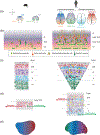Evaluation of advances in cortical development using model systems
- PMID: 35644985
- PMCID: PMC10924780
- DOI: 10.1002/dneu.22879
Evaluation of advances in cortical development using model systems
Abstract
Compared with that of even the closest primates, the human cortex displays a high degree of specialization and expansion that largely emerges developmentally. Although decades of research in the mouse and other model systems has revealed core tenets of cortical development that are well preserved across mammalian species, small deviations in transcription factor expression, novel cell types in primates and/or humans, and unique cortical architecture distinguish the human cortex. Importantly, many of the genes and signaling pathways thought to drive human-specific cortical expansion also leave the brain vulnerable to disease, as the misregulation of these factors is highly correlated with neurodevelopmental and neuropsychiatric disorders. However, creating a comprehensive understanding of human-specific cognition and disease remains challenging. Here, we review key stages of cortical development and highlight known or possible differences between model systems and the developing human brain. By identifying the developmental trajectories that may facilitate uniquely human traits, we highlight open questions in need of approaches to examine these processes in a human context and reveal translatable insights into human developmental disorders.
Keywords: cortical development; human; model organisms.
© 2022 Wiley Periodicals LLC.
Conflict of interest statement
CONFLICT OF INTEREST
The authors declare no conflicts of interest.
Figures

References
-
- Alcamo EA, Chirivella L, Dautzenberg M, Dobreva G, Fariñas I, Grosschedl R, & McConnell SK (2008). Satb2 regulates callosal projection neuron identity in the developing cerebral cortex. Neuron, 57(3), 364–377. - PubMed
-
- Allman JM, Tetreault NA, Hakeem AY, Manaye KF, Semendeferi K, Erwin JM, Park S, Goubert V, & Hof PR (2010). The von Economo neurons in frontoinsular and anterior cingulate cortex in great apes and humans. Brain Structure and Function, 214(5), 495–517. - PubMed
Publication types
MeSH terms
Grants and funding
LinkOut - more resources
Full Text Sources

